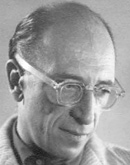

Alfred Neumann
*26. 1. 1900 – Wien, Austria
†23. 10. 1968 – Québec, Canada
Biography
Alfred Neumann was an Israeli architect who came from Austria-Hungary and later Czechoslovakia. At the age of ten, he moved with his family to Brno, where his father ran a carpentry workshop. After studying at the German State Technical School, he enrolled at the German Technical University in Brno after the establishment of Czechoslovakia. In 1922, he was accepted into the Vienna Academy, where he studied under Peter Behrens. After graduating, in the 1920s, he focused on furniture design and later also on building projects, in Paris (1925), Algeria (1928–29), and briefly in the Republic of South Africa. During World War II, he was deported to the Terezin concentration camp in the last transport due to his Jewish origin. He managed to survive and returned to Brno. In 1947, he represented Czechoslovakia at the Congrès International d'Architecture Moderne (CIAM) meeting in Bridgwater, England. After February 1948, he emigrated to Israel, where he worked until 1965. He arrived in Israel in 1949 and joined the studio of architect Richard Kaufmann. From 1950 to 1953, he worked at the Institute for Urban Planning. In 1952, he began teaching at the Israeli Institute of Technology, known as the Technion, in northern Israeli Haifa, where he later became the dean of the architecture faculty. In 1953, he again attended a CIAM meeting, this time in Aix-en-Provence, France, representing Israel. In 1958, he embarked on a journey around the world to seek new inspirations. A year later, he established his own architectural studio, inviting two of his students from the Technion: Zvi Hecker and Eldar Sharon. Together, they won, among other things, a competition to design the town hall building in Bat Yam.
Right in Haifa at the Technion, Neumann and Hecker realized the building for the mechanical workshops of the Faculty of Engineering, known as the Danziger House. However, the faculty administration was dissatisfied with the construction, wanted to dismiss the architects, and halt the project. Ultimately, due to ongoing delays in construction, a lawsuit ensued, with Neumann suing the rector of the Technion. However, he lost the case and decided in 1965 to leave the Technion and Israel. Neumann's last project, which he began before the conflict in Haifa, was the Central Officers' School in Micpe Ramon. It was completed only in 1969, a year after Neumann's death.
Meanwhile, Neumann left Israel at the age of sixty-five and moved to Canada, where he began teaching at Laval University in Quebec. He remarried, to a former student, and had a child. However, in 1968, he died of lung cancer, which he had caused by heavy smoking.
Alfred Neumann was an Israeli architect who came from Austria-Hungary and later Czechoslovakia. At the age of ten, he moved with his family to Brno, where his father ran a carpentry workshop. After studying at the German State Technical School, he enrolled at the German Technical University in Brno after the establishment of Czechoslovakia. In 1922, he was accepted into the Vienna Academy, where he studied under Peter Behrens. After graduating, in the 1920s, he focused on furniture design and later also on building projects, in Paris (1925), Algeria (1928–29), and briefly in the Republic of South Africa. During World War II, he was deported to the Terezin concentration camp in the last transport due to his Jewish origin. He managed to survive and returned to Brno. In 1947, he represented Czechoslovakia at the Congrès International d'Architecture Moderne (CIAM) meeting in Bridgwater, England. After February 1948, he emigrated to Israel, where he worked until 1965. He arrived in Israel in 1949 and joined the studio of architect Richard Kaufmann. From 1950 to 1953, he worked at the Institute for Urban Planning. In 1952, he began teaching at the Israeli Institute of Technology, known as the Technion, in northern Israeli Haifa, where he later became the dean of the architecture faculty. In 1953, he again attended a CIAM meeting, this time in Aix-en-Provence, France, representing Israel. In 1958, he embarked on a journey around the world to seek new inspirations. A year later, he established his own architectural studio, inviting two of his students from the Technion: Zvi Hecker and Eldar Sharon. Together, they won, among other things, a competition to design the town hall building in Bat Yam.
Right in Haifa at the Technion, Neumann and Hecker realized the building for the mechanical workshops of the Faculty of Engineering, known as the Danziger House. However, the faculty administration was dissatisfied with the construction, wanted to dismiss the architects, and halt the project. Ultimately, due to ongoing delays in construction, a lawsuit ensued, with Neumann suing the rector of the Technion. However, he lost the case and decided in 1965 to leave the Technion and Israel. Neumann's last project, which he began before the conflict in Haifa, was the Central Officers' School in Micpe Ramon. It was completed only in 1969, a year after Neumann's death.
Meanwhile, Neumann left Israel at the age of sixty-five and moved to Canada, where he began teaching at Laval University in Quebec. He remarried, to a former student, and had a child. However, in 1968, he died of lung cancer, which he had caused by heavy smoking.
The English translation is powered by AI tool. Switch to Czech to view the original text source.










